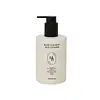What's inside
What's inside
 Key Ingredients
Key Ingredients

 Benefits
Benefits

 Concerns
Concerns

 Ingredients Side-by-side
Ingredients Side-by-side

Citrus Junos Fruit Water
MaskingWater
Skin ConditioningVigna Radiata Seed Extract
Skin ConditioningGlycerin
HumectantSimmondsia Chinensis Seed Oil
EmollientPropylene Glycol Dicaprylate/Dicaprate
EmollientGlycine Soja Seed Extract
Skin ConditioningGlycine Soja Oil
EmollientDecyl Glucoside
CleansingBetaine
HumectantPolyglyceryl-3 Methylglucose Distearate
EmulsifyingCetearyl Alcohol
EmollientButylene Glycol
HumectantGlyceryl Stearate
EmollientSchisandra Chinensis Fruit Extract
Skin ConditioningArtemisia Princeps Leaf Water
MaskingCamellia Sinensis Leaf Water
MaskingGlycine Soja Peptide
Skin ConditioningAvena Sativa Peptide
Skin ConditioningGlycine Max Polypeptide
Skin ConditioningTriticum Aestivum Peptide
Skin ConditioningLactobacillus Ferment
Skin ConditioningLactococcus Ferment
Skin ConditioningRehmannia Glutinosa Root Extract
Skin ConditioningCornus Officinalis Fruit Extract
Skin ConditioningAlisma Orientale Tuber Extract
Skin ConditioningCoptis Japonica Root Extract
Skin ConditioningDioscorea Japonica Root Extract
Skin ConditioningPaeonia Suffruticosa Root Extract
Skin ProtectingSmilax Glabra Root Extract
Skin ConditioningArtemisia Annua Extract
MaskingLepidium Meyenii Root Extract
Skin ConditioningOryza Sativa Extract
AbsorbentStellaria Media Extract
Skin ConditioningAvena Sativa Meal Extract
SoothingHydrolyzed Vegetable Protein
Skin ConditioningGlycoproteins
Skin ConditioningMaltodextrin
AbsorbentTromethamine
Buffering1,2-Hexanediol
Skin ConditioningXanthan Gum
EmulsifyingSodium Stearoyl Glutamate
CleansingPentylene Glycol
Skin ConditioningAcrylates/C10-30 Alkyl Acrylate Crosspolymer
Emulsion StabilisingPolyquaternium-51
Skin ConditioningPropanediol
SolventCyanocobalamin
Skin ConditioningSorbitan Stearate
EmulsifyingHydroxyacetophenone
AntioxidantEthylhexylglycerin
Skin ConditioningPalmitic Acid
EmollientStearic Acid
CleansingDisodium EDTA
Citrus Junos Fruit Water, Water, Vigna Radiata Seed Extract, Glycerin, Simmondsia Chinensis Seed Oil, Propylene Glycol Dicaprylate/Dicaprate, Glycine Soja Seed Extract, Glycine Soja Oil, Decyl Glucoside, Betaine, Polyglyceryl-3 Methylglucose Distearate, Cetearyl Alcohol, Butylene Glycol, Glyceryl Stearate, Schisandra Chinensis Fruit Extract, Artemisia Princeps Leaf Water, Camellia Sinensis Leaf Water, Glycine Soja Peptide, Avena Sativa Peptide, Glycine Max Polypeptide, Triticum Aestivum Peptide, Lactobacillus Ferment, Lactococcus Ferment, Rehmannia Glutinosa Root Extract, Cornus Officinalis Fruit Extract, Alisma Orientale Tuber Extract, Coptis Japonica Root Extract, Dioscorea Japonica Root Extract, Paeonia Suffruticosa Root Extract, Smilax Glabra Root Extract, Artemisia Annua Extract, Lepidium Meyenii Root Extract, Oryza Sativa Extract, Stellaria Media Extract, Avena Sativa Meal Extract, Hydrolyzed Vegetable Protein, Glycoproteins, Maltodextrin, Tromethamine, 1,2-Hexanediol, Xanthan Gum, Sodium Stearoyl Glutamate, Pentylene Glycol, Acrylates/C10-30 Alkyl Acrylate Crosspolymer, Polyquaternium-51, Propanediol, Cyanocobalamin, Sorbitan Stearate, Hydroxyacetophenone, Ethylhexylglycerin, Palmitic Acid, Stearic Acid, Disodium EDTA
 Reviews
Reviews

Ingredients Explained
These ingredients are found in both products.
Ingredients higher up in an ingredient list are typically present in a larger amount.
Cetearyl alcohol is a mixture of two fatty alcohols: cetyl alcohol and stearyl alcohol. It is mainly used as an emulsifier. Emulsifiers help prevent the separation of oils and products. Due to its composition, it can also be used to thicken a product or help create foam.
Cetearyl alcohol is an emollient. Emollients help soothe and hydrate the skin by trapping moisture.
Studies show Cetearyl alcohol is non-toxic and non-irritating. The FDA allows products labeled "alcohol-free" to have fatty alcohols.
This ingredient is usually derived from plant oils such as palm, vegetable, or coconut oils. There is debate on whether this ingredient will cause acne.
Due to the fatty acid base, this ingredient may not be Malassezia folliculitis safe.
Learn more about Cetearyl AlcoholGlycerin is already naturally found in your skin. It helps moisturize and protect your skin.
A study from 2016 found glycerin to be more effective as a humectant than AHAs and hyaluronic acid.
As a humectant, it helps the skin stay hydrated by pulling moisture to your skin. The low molecular weight of glycerin allows it to pull moisture into the deeper layers of your skin.
Hydrated skin improves your skin barrier; Your skin barrier helps protect against irritants and bacteria.
Glycerin has also been found to have antimicrobial and antiviral properties. Due to these properties, glycerin is often used in wound and burn treatments.
In cosmetics, glycerin is usually derived from plants such as soybean or palm. However, it can also be sourced from animals, such as tallow or animal fat.
This ingredient is organic, colorless, odorless, and non-toxic.
Glycerin is the name for this ingredient in American English. British English uses Glycerol/Glycerine.
Learn more about GlycerinWater. It's the most common cosmetic ingredient of all. You'll usually see it at the top of ingredient lists, meaning that it makes up the largest part of the product.
So why is it so popular? Water most often acts as a solvent - this means that it helps dissolve other ingredients into the formulation.
You'll also recognize water as that liquid we all need to stay alive. If you see this, drink a glass of water. Stay hydrated!
Learn more about WaterXanthan gum is used as a stabilizer and thickener within cosmetic products. It helps give products a sticky, thick feeling - preventing them from being too runny.
On the technical side of things, xanthan gum is a polysaccharide - a combination consisting of multiple sugar molecules bonded together.
Xanthan gum is a pretty common and great ingredient. It is a natural, non-toxic, non-irritating ingredient that is also commonly used in food products.
Learn more about Xanthan Gum